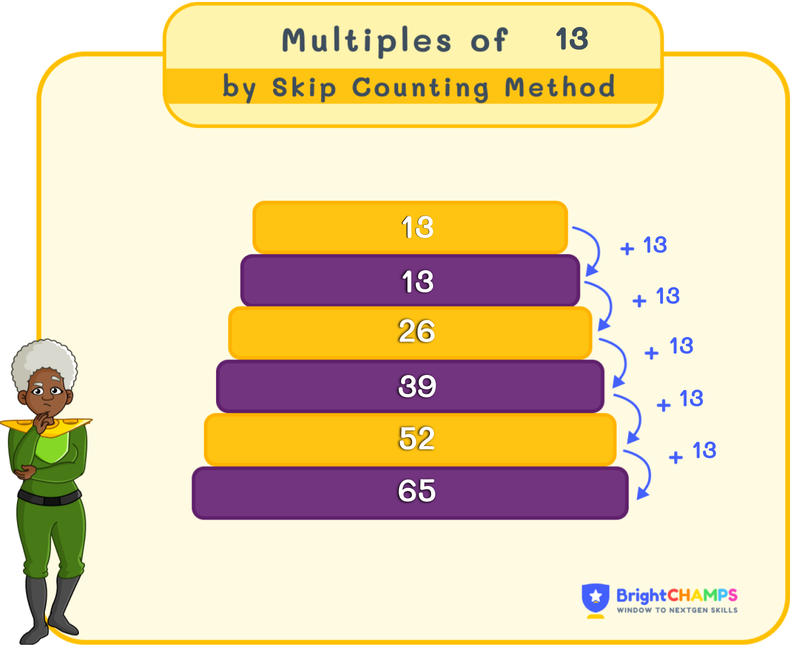
 240 Learners
240 LearnersLast updated on May 26th, 2025

Multiples of 13

In math, multiples are the products we get while multiplying a number with other numbers. Multiples play a key role in construction and design, counting groups of items, sharing resources equally, and managing time effectively. In this topic, we will learn the essential concepts of multiples of 13.
What are the Multiples of 13?
Now, let us learn more about multiples of 13. Multiples of 13 are the numbers you get when you multiply 13 by any whole number, along with zero. Each number has an infinite number of multiples, including a multiple of itself.
In multiplication, a multiple of 13 can be denoted as 13 × n, where ‘n’ represents any whole number (0, 1, 2, 3,…). So, we can summarize that:
Multiple of a number = Number × Any whole number
For example, multiplying 13 × 1 will give us 13 as the product. Multiples of 13 will be larger or equal to 13.

List of First 20 Multiples of 13
Multiples of 13 include the products of 13 and an integer. Multiples of 13 are divisible by 13 evenly. The first few multiples of 13 are given below:
| TABLE OF 13 (1-10) | |
|---|---|
|
13 x 1 = 13 |
13 x 6 = 78 |
|
13 x 2 = 26 |
13 x 7 = 91 |
|
13 x 3 = 39 |
13 x 8 = 104 |
|
13 x 4 = 52 |
13 x 9 = 117 |
|
13 x 5 = 65 |
13 x 10 = 130 |
| TABLE OF 13 (11-20) | |
|---|---|
|
13 x 11 = 143 |
13 x 16 = 208 |
|
13 x 12 = 156 |
13 x 17 = 221 |
|
13 x 13 = 169 |
13 x 18 = 234 |
|
13 x 14 = 182 |
13 x 19 = 247 |
|
13 x 15 = 195 |
13 x 20 = 260 |
Now, we know the first few multiples of 13. They are 0, 13, 26, 39, 52, 65, 78, 91, 104, 117, 130,...
Operations with Multiples of 13
Understanding the multiples of 13 helps solve mathematical problems and boost our multiplication and division skills. When working with multiples of 13, we need to apply them to different mathematical operations such as addition, subtraction, multiplication, and division.
Sum of first 5 Multiples of 13:
13, 26, 39, 52, and 65 are the first five multiples of 13. When multiplying 13 from 1 to 5, we get these numbers as the products.
So, the sum of these multiples is:
13 + 26 + 39 + 52 + 65 = 195
When we add the first 5 multiples of 13, the answer will be 195.
Subtraction of first 5 Multiples of 13:
While we do subtraction, it improves our comprehension of how the value decreases when each multiple is subtracted from the previous one. 13, 26, 39, 52, and 65 are the first five multiples of 13. So, let us calculate it as given below:
13 - 26 = -13
-13 - 39 = -52
-52 - 52 = -104
-104 - 65 = -169
Hence, the result of subtracting the first 5 multiples of 13 is -169.
Average of first 5 Multiples of 13:
To calculate the average, we need to identify the sum of the first 5 multiples of 13, and then divide it by the count, i.e., 5. Because there are 5 multiples presented in the calculation. Averaging helps us to understand the concepts of central tendencies and other values. We know the sum of the first 5 multiples of 13 is 195.
13 + 26 + 39 + 52 + 65 = 195
Next, divide the sum by 5:
195 ÷ 5 = 39
39 is the average of the first 5 multiples of 13.
Product of First 5 Multiples of 13:
The product of given numbers is the result of multiplying all of them together. Here, the first 5 multiples of 13 include: 13, 26, 39, 52, and 65. Now, the product of these numbers is:
13 × 26 × 39 × 52 × 65 = 57,179,580
The product of the first 5 multiples of 13 is 57,179,580.
Division of First 5 Multiples of 13:
While we perform division, we get to know how many times 13 can fit into each of the given multiples. 13, 26, 39, 52, and 65 are the first 5 multiples of 13.
13 ÷ 13 = 1
26 ÷ 13 = 2
39 ÷ 13 = 3
52 ÷ 13 = 4
65 ÷ 13 = 5
The results of dividing the first 5 multiples of 13 are: 1, 2, 3, 4, and 5.

Common Mistakes and How to Avoid Them in Multiples of 13
While working with multiples of 13, we make common mistakes. Identifying these errors and understanding how to avoid them can be helpful. Below are some frequent mistakes and tips to avoid them:

Multiples of 13 Examples

Problem 1
A group of friends is participating in a charity walkathon where each participant pledges to walk 13 miles. If 5 friends join the walkathon and each completes the distance, how many total miles will they walk together?

65 miles
Explanation
Each friend walks 13 miles. With 5 friends participating, the total distance is calculated by multiplying 13 by 5.
13 × 5 = 65
The group will walk a total of 65 miles.

Problem 2
In an art project, students are tasked with creating sculptures using blocks. Each sculpture requires 13 blocks. If the students make the first three sculptures using the first three multiples of 13 blocks respectively, how many blocks are used for each sculpture?

The first sculpture uses 13 blocks, the second uses 26 blocks, and the third uses 39 blocks.
Explanation
The first three multiples of 13 are:
13 × 1 = 13
13 × 2 = 26
13 × 3 = 39
Thus, the first sculpture uses 13 blocks, the second uses 26 blocks, and the third uses 39 blocks.

Problem 3
A music teacher has 13 musical instruments in each section of the orchestra. If there are 4 sections in total, how many instruments are there?

52 instruments
Explanation
Each section has 13 instruments. With 4 sections in the orchestra, we calculate the total number of instruments by multiplying 13 by 4.
13 × 4 = 52
Therefore, there are 52 musical instruments in total.

Problem 4
During a gardening project, each volunteer plants 13 seeds in a row. If there are 6 rows in the garden, how many seeds are planted in total?

78 seeds
Explanation
Each row contains 13 seeds. With 6 rows, we find the total number of seeds by multiplying the number of rows by the number of seeds in each row.
13 × 6 = 78
In total, 78 seeds are planted in the garden.

Problem 5
A librarian is shelving books in a library. The first shelf holds 13 books, the second shelf holds 26 books, and the third shelf holds 39 books. How many books are there on all three shelves?

78 books
Explanation
The first shelf holds 13 books, the second shelf holds 26 books, and the third shelf holds 39 books. Thus, the total number of books is:
13 + 26 + 39 = 78
Therefore, there are a total of 78 books on all three shelves.


FAQs on Multiples of 13
1.How do you find the multiples of 13?
2.What is the LCM of 7 and 13?
3.What are the real-life applications of Multiples of 13?
4.Are multiples of 13 finite or infinite?
5.Is there any odd multiple of 13?
6.How can poems help children in Singapore memorize the Multiplication Table and Multiples of 13?
7.Can learning the Multiplication Table influence creativity in solving Multiples of 13 challenges for kids in Singapore?
8.How do language and cultural differences in Singapore affect the way children learn the Multiplication Table and Multiples of 13?
9.What role does brain development play in mastering the Multiplication Table and Multiples of 13 among early learners in Singapore?
Important Glossaries for Multiples of 13
- Multiple: A multiple represents the product of a number that may be multiplied by an integer. For example, multiples of 13 include 13, 26, 39, 52, etc.
- Number pattern: This refers to how numbers are listed. It should follow a certain sequence. Multiples of 13 are the numbers that consist of the number pattern of 13.
- Odd number: An odd number refers to any number that cannot be divided by 2 without leaving a remainder. The last digits of odd numbers are 1, 3, 5, 7, or 9. Some multiples of 13 are odd numbers.
- Divisor: It refers to any number by which another number can be divided without leaving any remainder. 1 and 13 are the divisors of 13.
- LCM (Least Common Multiple): The smallest multiple that two or more numbers share. For example, the LCM of 7 and 13 is 91.
Explore More multiplication-tables
![Important Math Links Icon]() Previous to Multiples of 13
Previous to Multiples of 13
About BrightChamps in Singapore


Seyed Ali Fathima S
About the Author
Seyed Ali Fathima S a math expert with nearly 5 years of experience as a math teacher. From an engineer to a math teacher, shows her passion for math and teaching. She is a calculator queen, who loves tables and she turns tables to puzzles and songs.
Fun Fact
: She has songs for each table which helps her to remember the tables




